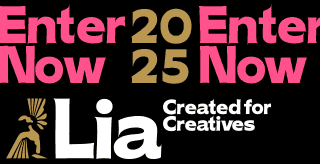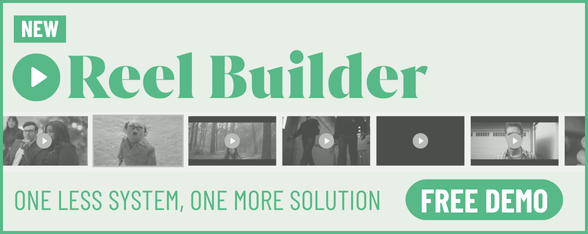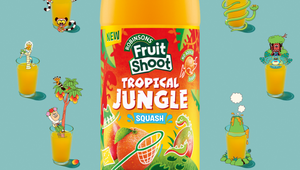
Clubcamping and the Controllable Chaos of Animation

Clubcamping is a directing duo producing top-tier, character-driven, action-packed 2D animation for major brands like Ikea, Porsche, and adidas.
Their dynamic, high-energy, and fluid animations put storytelling front and centre, resulting in expressive, detail-oriented designs that strive to be truly singular and mind-bending.
Led by Ana Sieglitz and Mariano Fernández Russo, Clubcamping was born under the Leo sun in Buenos Aires. Carrying true Leo energy – they are fueled by a deep passion for animation and a collaborative spirit, where creativity flows freely and every project is an adventure.
Ana and Mariano sat down with LBB on discovering their love and talent for animation, the industry giants that inspired them and their work on ‘The Legend of Pedro Rodriguez’...
LBB> How did you fall in love with animation?
Mariano> I remember when I was a kid I found my uncle´s drawings from when he was a kid, and I was mesmerised.
I also found a batch of bingo cartons, where he drew animations on the margins on the back, that you could use as flipbooks. I remember a cowboy shootout. I could go frame by frame looking at the specific drawings that made the effect work. I couldn’t clearly understand what was going on, but I felt undeniably attracted to the mechanics.
Ana> I honestly can’t remember a time without animation in my life. Growing up in the ‘90s, every morning was the same ritual: hot chocolate, bread with butter (Brazilians will get this), and cartoons. I was glued to the Cartoon Cartoons era: ‘Dexter’s Lab’, ‘The Powerpuff Girls’, ‘Courage the Cowardly Dog’… and then on Nickelodeon: ‘Hey Arnold’, ‘Rocko’s Modern Life’, and ‘Doug’. Back then I didn’t fully understand why I was so obsessed (and still am!), but I knew I wanted to be close to that world somehow.
LBB> Tell us about the animation project that kick started your career?
Mariano> I was 20. Up to that point in my life, the only animations I’d ever done were homemade clips with Macromedia Flash. And I didn't even know animation was a career path. I was studying filmmaking at university.
Then I entered a small but foundational animation studio. My first task was to fully animate characters and paint backgrounds for a slot machine. I remember the theme was ‘a wedding at a tropical beach’. I had to animate the groom, several brides and paint a hella lot of flower garlands!
I started on paper, but then quickly things got digital. I was so noob that at some points I didn't even notice I was making so many mistakes, but the older guys were so supportive.
When the project was somehow finished, I was fundamentally transformed. I felt it in my body and soul. Something clicked inside me, and I felt that all the cartoons, comics, movies and games I’d played before were pushing me in that direction. I now had a foot inside the animation world, and from there there was no going back.
Ana> I think my first project wasn’t technically animation, but it was the first time I felt close to it. I was studying journalism and thought maybe TV was the way to animation, so in my early twenties I landed a job at one of the biggest TV networks in Brazil.
My very first assignment was producing a promo for SpongeBob SquarePants. I was so excited I completely lost track of time and felt insanely proud of the result of that little promo. Later I found out that working in 2D animation was a very different journey, but that little SpongeBob promo still feels like the moment I found my way in.
LBB> How would you describe your art style and what are your biggest inspirations that developed it?
Mariano> I would say we don't have a specific art style. I think our strength is finding the right tone and style for each project, and then finding the way to bring our vibe. We like colours, textures, and characters above all. But what is a constant in our work is how we try to find unseen facets to ideas and visuals. We love to deconstruct things to find new layers of meaning.
Let’s say a project calls for a simple 2D aesthetic. We instantly are drawn to finding ways to bring depth and volume, without sacrificing one inch of the 2D vibe. We love creating concepts and rules that dictate how things should be done, and that applies to an almost infinite range of styles.
As for my inspirations, being a kid in the ‘90s, I’ve read a lot of comic books, watched a lot of cartoons, and played a lot of games, so my inspiration pool is quite gigantic.
I remember paying special attention to how Mark Bagley drew hands and feet, or loving and hating Todd McFarlane’s Spiderman poses.
I remember the branch-surfing scenes in Disney’s ‘Tarzan’, and judging how cheap the animation looked in the Iron Man cartoon, and how amazing it looked in the Batman cartoon. I remember imitating Captain Tsubasa’s football tricks, and pretending to shoot a thousand punches like Seiya.
I’m also a big nerd for absolute masters, so I have crushes on Michelangelo and Leonardo (the artists, not the turtles).
LBB> From your perspective, what’s the key to animation that really lives?
Clubcamping> A controllable amount of chaos.
LBB> Show us your favourite or most impactful project that you’ve worked on - tell us, what is it that makes it special and what were the memorable moments or challenges?
Clubcamping> One of our classics is ‘The Legend of Pedro Rodriguez’. The script was pretty open, which can be both a blessing and a curse, as we all know. It asked for a highly visual approach, full of metaphors, so we had to start completely from scratch. Facing that blank canvas, building a structure and inventing those visual metaphors was both terrifying and exciting, and it pushed us to grow in creativity, ambition and craft.
Later on, unexpected brief changes and delays tested us in ways we didn’t see coming. It forced us to rethink everything: the scope, the process, and even what it meant to pour so much of ourselves into a piece. In the end, though, that’s exactly what happened: we left a big part of ourselves in this project. That’s why whenever we rewatch it, we feel a deep emotional connection to it. It reflects our love for craft and reminds us that this may come with challenges.
By the time we finished we were exhausted (an understatement!), but it gave us resilience and confidence we didn’t have before. Even now, when a project gets tough, we go: “remember The Legend of Pedro Rodriguez? We survived that, we’ll survive this. And it turned out gorgeous!” lol For both of us, it’s still our favourite project, and probably always will be, because it defined an era for us.
LBB> How do you approach character design? What is your creative process like? Show us some of your favourite characters and their journey from notepad to screen.
Clubcamping> Our character design process has changed and evolved over the years. We’ve learned to listen to what each character needs in order to emerge as itself. Our job is simply to clear the way, much like the great master Michelangelo said (Like I said, I have a crush) as he chiselled the block of marble to release the figure trapped inside. (And of course we’re not comparing ourselves to Michelangelo. We lack both the talent and the papal favours.)
Naturally, as with any design process, there’s trial and error. Sometimes the path is clear; other times we try things and see what works.
There are no hard-and-fast rules or preset formulas for creating characters. We listen to our intuition and stay aligned with what feels true, sensing from within whether our choices are right or not.
LBB> Tell us more about observation and movement - what is the process you go through to study movement of characters?
Mariano> Just like in the design stage, how the characters and their world come to life, what timing and personality they take on, is an intuitive process. I like timing variations, changes in speed, and a range of acting that runs from very subtle drawing on real life and the everyday to fully expressive, frenetic, action-packed, and spectacular.
Within that universe of possibilities, different approaches are sometimes required. For movements and timings that need to convey humanity, our fail-safe is to record myself, making sure as few poor souls as necessary ever see that footage, and then destroy it.
For dynamic camera moves, action scenes, wild transitions, and VFX, we draw on our whole reservoir of pop culture, channeling our expressiveness and intuition until we find that perfect timing that doesn’t work the same with even a single frame more or less.
LBB> We all know of some ever-green adult animations, but lately they have definitely been on the rise, from Rick and Morty to Arcane. What sort of opportunities does this open for animators, both within and outside the advertising industry?
Clubcamping> We think adult animation going mainstream lets brands tell bolder, character-led stories without talking down to audiences. In advertising that means larger, serialised briefs, reusable worlds and characters, and healthier budgets for craft. Beyond ads, more buyers are seeking mature, creator-driven work, so a sharp short can credibly grow into a series, game, or book. Bottom line: it gives animators room to build IP while staying commercially relevant.
LBB> How does one figure out what kind of animation style or styles fits a particular story or project?
Clubcamping> Whenever a commercial project or pitch comes over, the existential dread rolls over: what? how? uh?
A particular skill that comes with experience (aka getting older) is learning to read or hear the signs, whispers and subtle directions that inherently come with a brief.
For personal projects, the process is a little bit more divergent. We can directly start with a style, and build from there, for example. But it’s usually a more intuitive process: if something feels right, despite not knowing why, we keep pushing. Same if something doesn’t feel right. We might change direction from a hunch.
LBB> What is your favourite piece of technology or software that you use and how does it help your creative process?
Mariano> For anyone expecting this answer to be about the latest gadget we use to transcribe thoughts into keyframes, or which AI platform we rely on to boost our design process, sorry to disappoint, but it’s none of that. Yes, we do use various generative image tools to help materialise our internal briefs, and we’re definitely interested in bringing mind-control workflows into our animation (no luck so far), but what really makes an incredible difference for me is the Rainy Mood app.
I brew some mate, put on my headphones, and let an incredibly hypnotic rain track play (seagulls included for extra effect). The creative trance I can reach is incomparable.
LBB> What sort of briefs or projects do you find more personally satisfying to work on?
Clubcamping: The briefs that present the opportunity to craft the world from scratch are the most interesting for us. It allows us to put our whole set of tools and skills to use, from the very beginning, from script all the way to post and vfx, and achieve that sort of creative control that invites you to invest your whole energy to establish a deep connection with the project.
By having this whole overview of a project, we can devise all kinds of workflows and experiments, pushing the boundaries of what we want to do, knowing that we have control of the schedule and its inner vicissitudes. That’s when we can safely throw a couple of pizza parties in.
LBB> What recent projects have really stood out for you and why?
Ana> One recent project we really loved was for Aldi Nord. It had a lot of subtle animation with a very human, realistic touch. The characters were just doing something as simple as shopping in a supermarket, yet every tiny action had to feel alive. Those small details are often the hardest, but they’re what make you connect with the characters.
On the other end of the spectrum, we’ve been developing a personal short (still unreleased) that’s the complete opposite: fast, dynamic, full of camera moves and energy. Going from the quiet subtleties of Aldi to that level of intensity felt like a yin and yang moment, and that range is something we really value.
LBB> Who is your animation hero and what is it about their work that inspires you? What example of their work particularly stands out?
Mariano> I don’t really have a single animation hero, to be honest, that’s something I’ve been unpacking in therapy for a while. I do admire many of the greats, past and present, for specific reasons: Genndy Tartakovsky’s expressiveness; John Pomeroy’s old-school technique; Benjy Brooke’s command of volume; the softness in Ghibli’s animation; and the rough, rustic energy of Toriyama’s.
LBB> Outside of the field of animation, what really inspires you?
Mariano> I personally love cooking. There’s something about the chemistry, and the creative input it needs that I find very akin to our known animation workflows. I`m actually thinking of studying to be a chef! I really resonate with the notion of knowing the tools to then be able to disrupt processes or improvise freely.
Ana> I get inspired by having a bunch of hobbies. Some are connected to art, some not at all, but they all expand my mind in different ways. I’ve gone through phases with astrology, tarot, ceramics, collage, jewelry-making… the full millennial starter pack.
I’m also a big fan of the “soft life” concept. Sometimes the most inspiring thing is just slowing down, hanging out with my cats, and balancing out the intensity of advertising with a little quiet. And of course, endless films and series.
LBB> What do you think are the misconceptions about animation throughout the industry?
Ana> I think one of the big misconceptions is that 2D may be faster and cheaper than live action or 3D. We see that a lot. Yes, we use digital tools, and yes, we’re poking around with AI. But let’s be real: if there was a magic button to do this, we’d be smashing it from time to time.
The truth is, it’s still a super handmade process. Every frame is built piece by piece, almost like sculpting. It's a controlled chaos, from the outside it might look smooth, but behind the curtain it’s just a lot of sweat, caffeine, and stubborn love for the craft.
LBB> What are the biggest changes to animation and challenges facing animators at the moment and what are your thoughts on them?
Ana> I guess we can’t answer this without talking about AI (Sorry!). Nobody really knows yet if it’s just a tool or a replacement, and our role in it is still blurry. The pace is insane, things shift literally day by day, sometimes faster than this industry can handle.
Add to that the general instability in the world, and you get tighter deadlines and budgets, and higher expectations. Honestly, half the time it feels like we’re all just winging it.
My way of staying sane is to take it step by step and not drown in the noise (at least on good days). For us, it’s about holding on to what truly represents us, letting go of what doesn’t, and paying attention to the new opportunities this chaos actually opens.
In our case, we've been leaning more into creative strategy and thinking, which maybe didn’t have as much room before. So yeah, chaos, but also some unexpected doors.
LBB> Any advice you would like to give to aspiring artists?
Ana> Don’t wait for things to feel ‘perfect’ before you start or post something. Just start making stuff. No worries, you’ll figure out your style along the way, and that’s half the fun (and half the pain).
Keep experimenting, and remember that nobody really knows what they’re doing… we’re all just faking it a little better each time.















